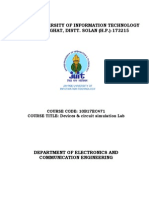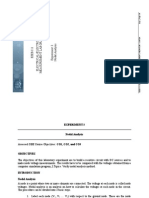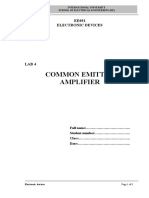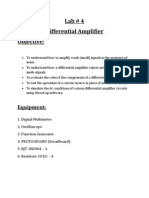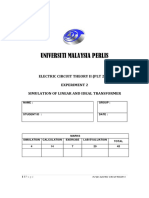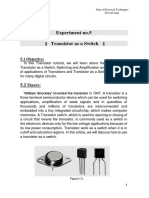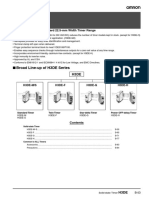LabInstr EE320L Lab7
LabInstr EE320L Lab7
Uploaded by
baig79Copyright:
Available Formats
LabInstr EE320L Lab7
LabInstr EE320L Lab7
Uploaded by
baig79Original Title
Copyright
Available Formats
Share this document
Did you find this document useful?
Is this content inappropriate?
Copyright:
Available Formats
LabInstr EE320L Lab7
LabInstr EE320L Lab7
Uploaded by
baig79Copyright:
Available Formats
EE 320 L ELECTRONICS I
LABORATORY 7: BIPOLAR TRANSISTOR CHARACTERIZATIONS
DEPARTMENT OF ELECTRICAL AND COMPUTER ENGINEERING
UNIVERSITY OF NEVADA, LAS VEGAS
1. OBJECTIVE
Get familiar with BJTs, and apply knowledge learned in lecture to practical applications.
Understand how to set up DC bias for BJTs so that it works as designed.
2. COMPONENTS & EQUIPMENT
Power Supply Breadboard & Jump wires
Function Generator Resistors & Capacitors
Multimeter BJT (2N2222A, 2N3904, 2N3906)
Oscilloscope
3. BACKGROUND
A bipolar junction transistor (bipolar transistor or BJT) is a type of transistor that uses both
electron and hole charge carriers. BJTs use two junctions between two semiconductor types, n-
type and p-type, and they manufactured in two types, NPN and PNP.
A terminal is connected to each of the three semiconductor regions of the transistor, with the
terminals labeled emitter (E), base (B), and collector (C). Each transistor consists of two pn
junctions, the emitter-base junction (EBJ) and the collector-base junction (CBJ). Three BJT modes
of operation: 1) Cutoff, 2) Active, 3) Saturation.
Key knowledges and formulas related to BJTs.
DEPARTMENT OF ELECTRICAL AND COMPUTER ENGINEERING 1
EE 320L ELECTRONICS I
A simple structure
of a npn transistor.
A simple structure
of a pnp transistor.
BJT modes of
operations.
DEPARTMENT OF ELECTRICAL AND COMPUTER ENGINEERING 2
EE 320L ELECTRONICS I
DEPARTMENT OF ELECTRICAL AND COMPUTER ENGINEERING 3
EE 320L ELECTRONICS I
Hybrid-𝝅 Model
(𝑔𝑚 𝑣𝜋 ) Version (𝛽𝑖𝑏 ) Version
DEPARTMENT OF ELECTRICAL AND COMPUTER ENGINEERING 4
EE 320L ELECTRONICS I
T Model
(𝑔𝑚 𝑣𝜋 ) Version (𝛼𝑖) Version
4. LAB DELIVERIES
PRELAB:
1. Learn the idea of BJT transistors, and understand the principles of various operation modes,
i.e. how the current flows through PN junctions under different operation modes. Part of
knowledge is covered in the previous section.
2. Overview the key character of BJT in the datasheet.
2N2222A https://www.onsemi.com/pub/Collateral/P2N2222A-D.PDF
2N3904 https://www.onsemi.com/pub/Collateral/2N3903-D.PDF
3. Use hand-calculation and LTspice to obtain the voltages at “vout” in Circuit 1.
1) Assume the threshold voltage for VBE to turn on Q2 (i.e. BJT 2N2222) is 0.7V and 𝛽=100.
Same as for all BJTs in other circuits.
2) Calculate and simulate the circuit for voltage at “vout” when V3 = 0.1V, 0.5V, 0.7V, 1V, 2V,
respectively.
3) (LTspice) Run DC sweep analysis (i.e. command in the diagram) for V3 from 0V to 5V.
Observe the voltage transfer characteristic (VTC) diagram.
DEPARTMENT OF ELECTRICAL AND COMPUTER ENGINEERING 5
EE 320L ELECTRONICS I
Circuit 1
4. Use hand-calculation and LTspice to compute/simulate the voltages at nb, nc, ne in Circuit 2.
1) Write down the voltages at nb, nc, ne.
2) Compute and simulate the currents flowing through nb (i.e I(R1)-I(R2)), nc (i.e. I(R3)) and ne
(i.e. I(R4)). What is the relationship among these current values?
3) Change R1 to 120Ω, and redo the computation and simulation for voltages and currents at nb,
nc, ne. Compare the results with 1). Explain.
Circuit 2
DEPARTMENT OF ELECTRICAL AND COMPUTER ENGINEERING 6
EE 320L ELECTRONICS I
5. Use LTspice to simulate Circuit 3.
Circuit 3
1) Add a sine waveform input between BJT’s base node (i.e. nb) and intermediate node of R1
and R2. Set the sine waveform with an amplitude of 0.1V and a frequency of 10Hz.
2) Simulate the voltages and currents at/through nc and ne.
3) Set R1 = 120Ω, and repeat 2). Compare the results.
4) Reset R1 back to 12KΩ. Increase the sine waveform frequency to 1KHz. Repeat 2).
5) Run AC analysis for Circuit 3 V2 (i.e. input AC signal) for Bode plot (i.e. AC component of
𝑉𝑛𝑐 as output) from 1Hz to 100MHz.
LAB EXPERIMENTS:
1. Implement and measure Circuit 1 in Prelab Experiment 3 on breadboard, and compare with
the hand-calculation and LTspice results.
• Sweep V3 input from DC 0V to 2V, with increment of 0.1V. Draw the VTC.
2. Implement and measure Circuit 2 in Prelab Experiment 4 on breadboard, and compare with
the hand-calculation and LTspice results.
DEPARTMENT OF ELECTRICAL AND COMPUTER ENGINEERING 7
EE 320L ELECTRONICS I
3. Implement and measure Circuit 3 in Prelab Experiment 5 on breadboard, and compare with
the hand-calculation and LTspice results.
• Use R1 = 12KΩ and V2 frequencies of 10Hz, 100Hz, 1KHz and 10KHz, 100KHz, 1MHz,
respectively, for measurement on board. Write down Vpp and draw the Bode plot.
• If Circuit 3 does not work, use the following Circuit 4 instead. Use the exact same value of 𝑉𝑛𝑏
measured in Circuit 2 for the offset “x” in function generator.
Circuit 4
POSTLAB REPORT:
Include the following elements in the report document:
Section Element
Theory of operation
1
Include a brief description of every element and phenomenon that appear during the experiments.
Prelab report
1. Is 2N2222A a PNP or NPN BJT?
2
2. Hand calculation and LTspice simulation results of Prelab Experiment 3.
3. LTspice simulation results of Prelab Experiment 4.
Results of the experiments
Experiments Experiment Results
3 1 Screenshots of LTspice simulations and multimeter readings for DC measurements.
2 Screenshots of LTspice simulations and oscilloscope waveforms.
3 Screenshots of LTspice simulations and oscilloscope waveforms.
Answer the questions
Questions Questions
In Lab Experiment 2 and 3 (i.e. Prelab Experiment 4 & 5), pls explain the voltage
1
4 and current changes when switching R1 from 12KΩ to 120Ω.
2 What do you expect to see if change 2N2222A to a PNP BJT?
Compare the Bode plot drawn in LTspice (Prelab Experiment 5) and Lab Experiment
3
5. Explain why different if any.
DEPARTMENT OF ELECTRICAL AND COMPUTER ENGINEERING 8
EE 320L ELECTRONICS I
Conclusions
5 Write down your conclusions, things learned, problems encountered during the lab and how they were solved,
etc.
Images
Paste images (e.g. scratches, drafts, screenshots, photos, etc.) in Postlab report document (only .docx, .doc or
.pdf format is accepted). If the sizes of images are too large, convert them to jpg/jpeg format first, and then
paste them in the document.
6
Attachments (If needed)
Zip your projects. Send through WebCampus as attachments, or provide link to the zip file on Google Drive /
Dropbox, etc.
5. REFERENCES & ACKNOWLEDGEMENT
1. Adel S. Sedra & Kenneth C. Smith, “Microelectronic Circuit”, 6th Ed.
2. Online sources: Google, Wikipedia, etc.
3. Previous lab instructions.
4. Related circuit component datasheets.
I appreciate the help from faculty members and TAs during the composing of this instruction
manual. I would also thank students who provide valuable feedback so that we can offer better
higher education to the students.
DEPARTMENT OF ELECTRICAL AND COMPUTER ENGINEERING 9
You might also like
- Lab 2 Nodal and Mesh AnalysisDocument2 pagesLab 2 Nodal and Mesh AnalysisMuhd Qayyum Mohd FuadNo ratings yet
- ELEC3509 Lab1 Day1Document13 pagesELEC3509 Lab1 Day1baig79No ratings yet
- Regulador 001 A5wDocument12 pagesRegulador 001 A5wvladimirNo ratings yet
- Project On Intelligent Digital Security SystemDocument33 pagesProject On Intelligent Digital Security SystemprasannachandraNo ratings yet
- Electronic Circuits I, II - Lecture Notes, Study Materials and Important Questions AnswersDocument5 pagesElectronic Circuits I, II - Lecture Notes, Study Materials and Important Questions AnswersBrainKart ComNo ratings yet
- LabInstr EE320L Lab9Document8 pagesLabInstr EE320L Lab9MjdNo ratings yet
- LabInstr_EE320L_Lab2Document8 pagesLabInstr_EE320L_Lab2trnamvietNo ratings yet
- PH 411 Physics Laboratory I (Electronics) : Instruction Manual IndexDocument28 pagesPH 411 Physics Laboratory I (Electronics) : Instruction Manual IndexReddyvari VenugopalNo ratings yet
- Lab01 Solution01Document9 pagesLab01 Solution01Abdul Hannan AdilNo ratings yet
- Ece 331 Lab Manual Spring 2021Document86 pagesEce 331 Lab Manual Spring 2021haiderNo ratings yet
- EE 230 - Analog Lab - 2021-22/I (Autumn) Experiment 4: Current Source, Current Mirror, and Differential PairDocument4 pagesEE 230 - Analog Lab - 2021-22/I (Autumn) Experiment 4: Current Source, Current Mirror, and Differential PairSruthiNo ratings yet
- Transistor Bias Design and Stability: Ee 3101 Electronics I Laboratory Experiment 4 Lab ManualDocument3 pagesTransistor Bias Design and Stability: Ee 3101 Electronics I Laboratory Experiment 4 Lab ManualIshtiaque Ahmed TanimNo ratings yet
- Lab 8Document10 pagesLab 8Mike AlbertNo ratings yet
- MBU BEEE Lab MergedDocument53 pagesMBU BEEE Lab MergedgaganseekerNo ratings yet
- Lap Manual Pspice PDFDocument17 pagesLap Manual Pspice PDFred_heartedNo ratings yet
- Laboratory Manual For Linear ElectronicsDocument102 pagesLaboratory Manual For Linear Electronicssamactrang100% (1)
- Eee312 Eee282 Lab7 Spring2015Document6 pagesEee312 Eee282 Lab7 Spring2015vognarNo ratings yet
- Electronics I (EECE 3110) Lab 5: MosfetsDocument9 pagesElectronics I (EECE 3110) Lab 5: Mosfetswaqas akramNo ratings yet
- ET1310 Lab 2.1 LabReportHandout OLDocument8 pagesET1310 Lab 2.1 LabReportHandout OLIreri MwanikiNo ratings yet
- EDC Lab 10Document14 pagesEDC Lab 10uf73735No ratings yet
- NT Lab MannualDocument25 pagesNT Lab Mannualsidhantfi9haiNo ratings yet
- Aust/Eee: Student Name: Student IDDocument32 pagesAust/Eee: Student Name: Student ID29 - 023 - Abid HasanNo ratings yet
- C-20 P e Practicle ComletetDocument80 pagesC-20 P e Practicle Comletetamrutha cNo ratings yet
- Lab 3 (Nodal Analysis)Document8 pagesLab 3 (Nodal Analysis)anon_938313424No ratings yet
- Wa0020.Document3 pagesWa0020.tradeviewmaxiNo ratings yet
- EEC ActivityDocument19 pagesEEC ActivityKerwin James AustriaNo ratings yet
- Other 22122021211053993Document6 pagesOther 22122021211053993Dhrubajit Acharya Bishal 222-15-6242No ratings yet
- SPICE Version 2G User's GuideDocument48 pagesSPICE Version 2G User's Guidexing tangNo ratings yet
- Common Emitter Amplifier: EE091 Electronic DevicesDocument8 pagesCommon Emitter Amplifier: EE091 Electronic DevicesVy NguyễnNo ratings yet
- AC Electrical Circuits Lab Manual 123Document98 pagesAC Electrical Circuits Lab Manual 123xyzzyzNo ratings yet
- Electronic Devices Lab - Exp - 10 - Student - Manual (Summer 18-19)Document4 pagesElectronic Devices Lab - Exp - 10 - Student - Manual (Summer 18-19)MD MONIM ISLAMNo ratings yet
- Sylllabus of 4th Semester - 25062022Document26 pagesSylllabus of 4th Semester - 25062022Suman GhoshNo ratings yet
- Lab # 4 Differential Amplifier Objective:: EquipmentDocument4 pagesLab # 4 Differential Amplifier Objective:: EquipmentIMSAAADNo ratings yet
- Laboratory Manual For Ac Electrical CircuitsDocument80 pagesLaboratory Manual For Ac Electrical CircuitsAngelo Palaming100% (1)
- College of Engineering: Electronics 2 LaboratoryDocument11 pagesCollege of Engineering: Electronics 2 LaboratoryJun TobiasNo ratings yet
- EEC ActivityDocument13 pagesEEC ActivityKerwin James AustriaNo ratings yet
- Lab3 Report W & HDocument77 pagesLab3 Report W & Hmatsurii1669No ratings yet
- Lab3 BJT Current MirrorsDocument5 pagesLab3 BJT Current MirrorsaublysodonNo ratings yet
- Ec Exp8Document6 pagesEc Exp8uçan otobüsNo ratings yet
- Lab0 120114Document6 pagesLab0 120114Bùi Thái HoàngNo ratings yet
- ED Lab Experiment Manual 5Document10 pagesED Lab Experiment Manual 5itpagla miaNo ratings yet
- Me2143/Me2143E Linear Circuits: Department of Mechanical Engineering National University of SingaporeDocument20 pagesMe2143/Me2143E Linear Circuits: Department of Mechanical Engineering National University of SingaporeQiao YuNo ratings yet
- ENGR2200 Lab Manual Lab2Document12 pagesENGR2200 Lab Manual Lab2Sure TipsNo ratings yet
- ECA ManualDocument50 pagesECA ManualkrajenderreddyNo ratings yet
- Design and Simulation of Wireless Power Transfer SystemsDocument6 pagesDesign and Simulation of Wireless Power Transfer SystemsMAD-BONDONo ratings yet
- Introduction To Electrical and Computer Engineering Lab ManualDocument124 pagesIntroduction To Electrical and Computer Engineering Lab Manualkstu1112No ratings yet
- Bee Lab ManualDocument69 pagesBee Lab ManualYash AryaNo ratings yet
- Lab Report 8Document8 pagesLab Report 8Nebil YisuNo ratings yet
- 359 Lab 1 NotesDocument13 pages359 Lab 1 Notessteve noboDNo ratings yet
- Institute of Industrial Electronics Engineering, (Pcsir) KarachiDocument11 pagesInstitute of Industrial Electronics Engineering, (Pcsir) KarachiQuratulain AnwarNo ratings yet
- Experiment 2 Lab ManualDocument6 pagesExperiment 2 Lab ManualSikat Gabriel L.100% (1)
- Experiment 2 20 - 21Document11 pagesExperiment 2 20 - 21Mohd khalil AkherNo ratings yet
- BJT Characteristics - EE311 - Spring 2022Document6 pagesBJT Characteristics - EE311 - Spring 2022Abdulhakim AldarhoubiNo ratings yet
- RTL NotDocument9 pagesRTL Notمعتصم الكاملNo ratings yet
- Electric Circuits: Lab Manual Experiment No 8Document6 pagesElectric Circuits: Lab Manual Experiment No 8usamaNo ratings yet
- Bee Expt 2 NepDocument4 pagesBee Expt 2 NepparagdfulzeleNo ratings yet
- Design and Simulation of DC Distributed Power Supply With Power Balance Control TechniqueDocument10 pagesDesign and Simulation of DC Distributed Power Supply With Power Balance Control TechniqueInternational Journal of Power Electronics and Drive SystemsNo ratings yet
- DEVICE EXP 2 Student - 2Document4 pagesDEVICE EXP 2 Student - 2Pablo ChanNo ratings yet
- Pe 4ee4-22 Lab ManualsDocument58 pagesPe 4ee4-22 Lab ManualsBackup DataNo ratings yet
- Switch 1Document6 pagesSwitch 1معتصم الكاملNo ratings yet
- Analog System Design ExperimentsDocument27 pagesAnalog System Design ExperimentsAnsh BhaganiaNo ratings yet
- Analog - Digital Electronics Lab ECS391Document21 pagesAnalog - Digital Electronics Lab ECS391ganeshdNo ratings yet
- Electromagnetic Compatibility (EMC) Design and Test Case AnalysisFrom EverandElectromagnetic Compatibility (EMC) Design and Test Case AnalysisNo ratings yet
- Design of Electrical Circuits using Engineering Software ToolsFrom EverandDesign of Electrical Circuits using Engineering Software ToolsNo ratings yet
- Lab.5 Power ElectronicsDocument7 pagesLab.5 Power Electronicsbaig79No ratings yet
- Transistor LabDocument3 pagesTransistor Labbaig79No ratings yet
- 251 HouDocument7 pages251 Houbaig79No ratings yet
- BME3512 SP17 Lab 4Document7 pagesBME3512 SP17 Lab 4baig79No ratings yet
- Microsoft PowerPoint - EGN3365-2b (Compatibility Mode)Document13 pagesMicrosoft PowerPoint - EGN3365-2b (Compatibility Mode)baig79No ratings yet
- 3-A-Full Wave RectifierDocument6 pages3-A-Full Wave Rectifierbaig79No ratings yet
- Appendix: 9.1 Functionals and Functional DerivativesDocument4 pagesAppendix: 9.1 Functionals and Functional Derivativesbaig79No ratings yet
- Metnum Ex1Document3 pagesMetnum Ex1baig79No ratings yet
- AE04 SolDocument126 pagesAE04 Solbaig79No ratings yet
- Wolf Imprs 2013Document40 pagesWolf Imprs 2013baig79No ratings yet
- Coupled Oscillators Many Coupled Oscillators From Oscillators To WavesDocument8 pagesCoupled Oscillators Many Coupled Oscillators From Oscillators To Wavesbaig79No ratings yet
- Chapter 9 Physical Optics.oDocument31 pagesChapter 9 Physical Optics.obaig79No ratings yet
- Functionalisation of Magnetic Nanoparticles For Applications in BiomedicineDocument10 pagesFunctionalisation of Magnetic Nanoparticles For Applications in Biomedicinebaig79No ratings yet
- Studies About Magnetic Hyperthermia With Superparamagnetic NanoparticlesDocument4 pagesStudies About Magnetic Hyperthermia With Superparamagnetic Nanoparticlesbaig79No ratings yet
- Chapt21 Lecture1Document25 pagesChapt21 Lecture1baig79No ratings yet
- MAE 343 Intermediate Mechanics of Materials: Xingbo Liu Office: ESB 509 Phone: 293-3339 Email: Xingbo - Liu@mail - Wvu.eduDocument38 pagesMAE 343 Intermediate Mechanics of Materials: Xingbo Liu Office: ESB 509 Phone: 293-3339 Email: Xingbo - Liu@mail - Wvu.edubaig79No ratings yet
- Simple Harmonic OscillatorsDocument7 pagesSimple Harmonic Oscillatorsbaig79No ratings yet
- Physics Midterm Practice TestDocument3 pagesPhysics Midterm Practice Testbaig79No ratings yet
- Electronics WorkshopDocument44 pagesElectronics Workshopnizarasheed76No ratings yet
- Automatic Power Factor Corrector Using Capacitive Load Bank Project ReportDocument60 pagesAutomatic Power Factor Corrector Using Capacitive Load Bank Project ReportUtkarsh Agrawal90% (10)
- Pe Lab Viva QuestionsDocument15 pagesPe Lab Viva Questionssujithmrinal100% (6)
- Data Sheet: Silicon MMIC AmplifierDocument13 pagesData Sheet: Silicon MMIC AmplifierjohnysonycumNo ratings yet
- Class Ab 2Document15 pagesClass Ab 2jay is kewlNo ratings yet
- 2N1305 CentralSemiconductorDocument5 pages2N1305 CentralSemiconductorAirton SousaNo ratings yet
- Project Proposal Title: Boost ConverterDocument6 pagesProject Proposal Title: Boost ConverterAsghar AmirNo ratings yet
- Uzu2 Series: Led Digital Display High Functionality Pressure SensorsDocument11 pagesUzu2 Series: Led Digital Display High Functionality Pressure SensorsJose Luiz QuerubinNo ratings yet
- Tiger Electronic Co.,Ltd: TO-92 Plastic-Encapsulate TransistorsDocument1 pageTiger Electronic Co.,Ltd: TO-92 Plastic-Encapsulate TransistorsHa TaNo ratings yet
- B.Tech. (ECE) 2nd Year)Document43 pagesB.Tech. (ECE) 2nd Year)mauga kumarNo ratings yet
- Analog Electronic Circuit Design: Dr. G V SubbaraoDocument45 pagesAnalog Electronic Circuit Design: Dr. G V SubbaraoVani telluriNo ratings yet
- Cmos Sequential CircuitsDocument33 pagesCmos Sequential Circuitslachuns123No ratings yet
- Syllabus: Electronic Circuit Design 1Document11 pagesSyllabus: Electronic Circuit Design 1Nhật NamNo ratings yet
- And Gate Using TransistorsDocument14 pagesAnd Gate Using TransistorsHmmam AltayebNo ratings yet
- Inductive Proximity Sensors PDFDocument231 pagesInductive Proximity Sensors PDFHassan AliNo ratings yet
- AC BJT Analysis Lecture 2Document6 pagesAC BJT Analysis Lecture 2Xxx CccNo ratings yet
- H3DE Twin TimerDocument33 pagesH3DE Twin TimerHemraj Singh RautelaNo ratings yet
- BCW71 BCW72 BCW71 BCW72: Sot23 NPN Planar Small Signal TransistorsDocument3 pagesBCW71 BCW72 BCW71 BCW72: Sot23 NPN Planar Small Signal TransistorsMisael GonzalezNo ratings yet
- Digital Logic Circuit With Verilog HDLDocument149 pagesDigital Logic Circuit With Verilog HDLaNo ratings yet
- ELET1500 FET Tutorial: NP P - NP PDocument3 pagesELET1500 FET Tutorial: NP P - NP PCadane CodnerNo ratings yet
- Balluff 315634 Object Detection CatalogDocument612 pagesBalluff 315634 Object Detection CatalogBalluff SensorsNo ratings yet
- Edc 4 UnitDocument26 pagesEdc 4 UnitAnonymous 6Ts3r7dwNo ratings yet
- Barrera Fotoelectricasna2-N e CataDocument9 pagesBarrera Fotoelectricasna2-N e CataEdison MaciasNo ratings yet
- BC546 / BC547 / BC548 / BC549 / BC550 NPN Epitaxial Silicon TransistorDocument7 pagesBC546 / BC547 / BC548 / BC549 / BC550 NPN Epitaxial Silicon TransistorrealaffiliateNo ratings yet
- Assignment BJTDocument4 pagesAssignment BJTRamNo ratings yet
- (Dennis L. Feucht) Transistor Amplifiers PDFDocument439 pages(Dennis L. Feucht) Transistor Amplifiers PDFspyeagleNo ratings yet
- 2SB 739 - HitachiDocument6 pages2SB 739 - HitachiStevenNo ratings yet














